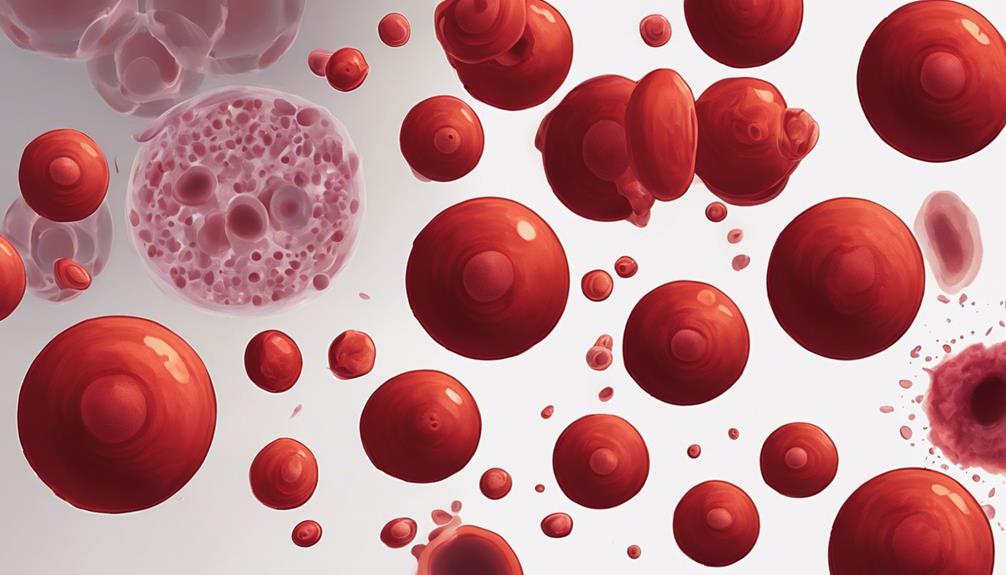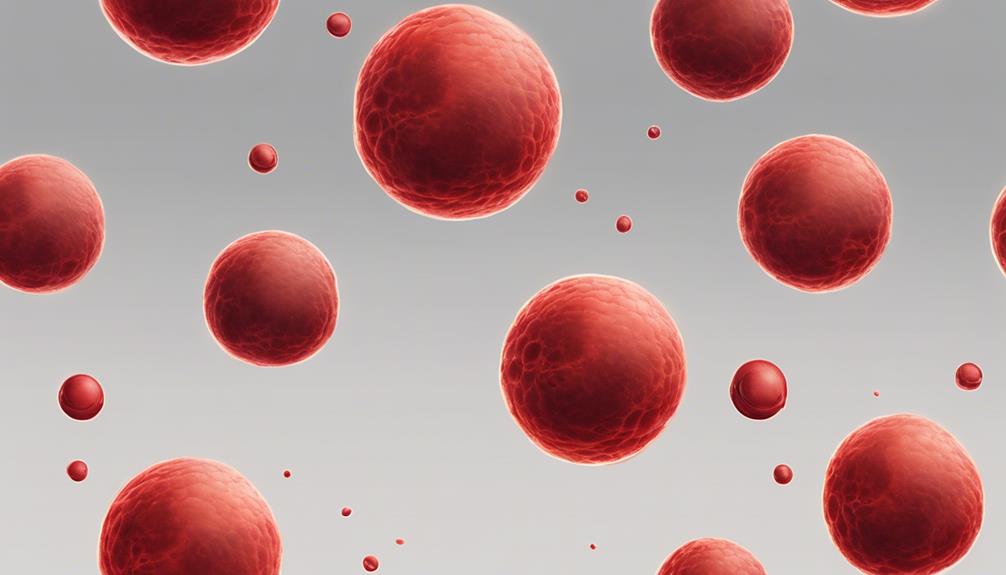Summary
- 1 Understanding Anisocytosis
- 2 Causes of Anisocytosis
- 3 Symptoms to watch out for
- 4 Diagnosis of Anisocytosis
- 5 Available treatment options
- 6 Complications of anisocytosis
- 7 Tips for prevention and management
- 8 Frequently asked questions
- 8.1 Can anisocytosis be a sign of a more serious underlying condition?
- 8.2 Is it common to see anisocytosis in specific age groups?
- 8.3 Are there lifestyle changes that can help manage anisocytosis?
- 8.4 Can Anisocytosis affect fertility or pregnancy?
- 8.5 Is anisocytosis related to certain dietary deficiencies?
Understanding anisocytosis is essential: it occurs when red blood cells differ in size, indicating possible health problems. Causes vary, from anemia to genetic disorders. Look for fatigue, breathlessness, pale skin as symptoms. Blood tests such as RDW and MCV help diagnose anisocytosis. Early diagnosis is crucial for timely treatment, avoiding complications. Monitoring and managing underlying issues is imperative for better health. Treatments range from supplements to lifestyle changes. Seeking medical advice for appropriate treatment is essential.
Understanding Anisocytosis

If you have ever wondered about the meaning of anisocytosis, it refers to a condition in which red blood cells vary in size. In a healthy individual, red blood cells are typically uniform in size, but in cases of anisocytosis, there is an obvious disparity in the size of these cells. This condition can be identified through a blood test known as a complete blood count (CBC). Anisocytosis can be indicative of various underlying health problems, such as nutritional deficiencies, chronic diseases, or bone marrow disorders.
Understanding anisocytosis is important because it can provide valuable perspectives on a person's health status. Monitoring changes in red blood cell size can help health care providers effectively diagnose and manage certain medical conditions. Although anisocytosis itself does not always cause symptoms, treating the underlying cause is essential to overall health and well-being.
Causes of Anisocytosis
Several factors may contribute to the development of theanisocytosis, leading to variation in the size of red blood cells. A common cause is theiron deficiency anemia, where the body does not have enough iron to produce sufficient hemoglobin, affecting the size and shape of red blood cells. Deficiencies in vitamin B12 or folic acid can lead to anisocytosis by affecting red blood cell production in the bone marrow.
Some chronic diseases such as liver disease, hypothyroidism or myelodysplastic syndrome can cause anisocytosis. In these conditions, the body's ability to produce healthy red blood cells is impaired, causing irregular cell size. In addition, some genetic disorders such as hereditary spherocytosis or thalassemia can lead to anisocytosis due to abnormalities in red blood cell structure.
Other causes include infections, conditions inflammatory or exposure to toxins. These factors can disrupt the normal process of formation of red blood cells, causing anisocytosis. Understanding these causes is essential for proper diagnosis and management of anisocytosis.
Symptoms to watch out for

When it comes to anisocytosis, it is important to pay attention to common symptoms such as fatigue and shortness of breath. Recognize signs such as. pale skin or irregular heartbeats may also indicate this condition. It is essential to monitor any red blood cell abnormalities to detect anisocytosis early and seek appropriate medical care.
Common symptoms of anisocytosis
Be alert for common symptoms of anisocytosis that may indicate underlying health problems. Anisocytosis, characterized by red blood cells of varying size, can manifest itself in several ways. Fatigue is a frequent symptom, as anisocytosis affects the body's ability to transport oxygen efficiently. Shortness of breath and dizziness may also occur due to the blood's reduced oxygen-carrying capacity. Pallor or jaundice may be evident, indicating potential problems with red blood cell production or destruction. In addition, an increased heart rate or palpitations may be present as the heart works harder to compensate for reduced blood oxygen levels. If you experience unexplained bruising or bleeding, it could be a sign of platelet abnormalities related to anisocytosis. Be alert to these symptoms and consult a health care provider if you notice troubling signs to receive proper diagnosis and treatment.
Recognizing the signs of anisocytosis
Pay attention to these signs that could indicate the presence of anisocytosis and possible underlying health problems. Anisocytosis can manifest itself through symptoms such as fatigue, dizziness and shortness of breath. If you experience unexplained weakness or fatigue even with adequate rest, it could be a sign of anisocytosis. Dizziness or light-headedness, especially when you get up quickly, could also indicate abnormal red blood cell size. Shortness of breath during activities that did not previously cause such difficulties could be another warning sign. In addition, pale skin, chest pain, and heart palpitations could suggest anisocytosis. Be alert to these symptoms and consult a health care provider if you notice that they persist or worsen. Early diagnosis and treatment of anisocytosis can help prevent further complications and protect your overall well-being.
Monitoring of blood cell abnormalities
Pay attention to common symptoms that may indicate abnormalities in blood cells, such as anisocytosis, to ensure a early detection And appropriate management. Keep an eye out for signs such as. unexplained fatigue, weakness, pale skin, shortness of breath, dizziness, frequent infections e ease of bruising can help you be proactive about your health. If you notice any of these symptoms persisting or worsening, it is vital to consult a healthcare professional promptly.
Regular monitoring of blood cell counts through routine blood tests is essential, especially if you have a history of anemia or other blood disorders. By tracking changes in blood cell levels over time, health care providers can identify abnormalities such as anisocytosis early and adjust treatment plans accordingly. Remember, early detection and intervention play a significant role in the effective management of blood cell abnormalities.
Do not ignore persistent symptoms or changes in your health. Being proactive and seeking medical attention when needed can make a substantial difference in the management of blood cell abnormalities such as anisocytosis.
Diagnosis of Anisocytosis
So how is anisocytosis diagnosed? Well, health care providers usually use blood tests to detect this condition by analyzing red blood cell distribution width (RDW) and mean corpuscular volume (MCV). Early detection is critical because anisocytosis can be a sign of underlying health problems, making early diagnosis essential for appropriate treatment.
Diagnostic methods for anisocytosis
Understanding the diagnostic methods for anisocytosis is essential to accurately identify this condition in patients. Typically, anisocytosis is detected through a complete blood count (CBC) test. This test provides valuable information about the size and shape of red blood cells, allowing health care providers to assess whether there is significant variation in cell size (anisocytosis).
Microscopic examination of a peripheral blood smear is another vital diagnostic method for anisocytosis. By visually inspecting blood cells under a microscope, health care providers can directly observe any abnormalities in cell size and shape. This method allows a more detailed analysis of anisocytosis and helps determine the underlying cause.
In addition, automated blood analyzers are commonly used to detect anisocytosis. These analyzers provide accurate and rapid results by measuring various red blood cell parameters, including red blood cell distribution width. An increase in red blood cell distribution width (RDW) may indicate the presence of anisocytosis.
Importance of Early Detection
Early detection of anisocytosis plays a critical role in the timely diagnosis and treatment of this condition. Detecting anisocytosis early can help health care providers identify any underlying health problems and initiate appropriate interventions in a timely manner. Here is an overview of the importance of early detection:
| Importance of Early Detection of Anisocytosis |
|---|
| 1. Timely Treatment |
| Early detection enables timely treatment, potentially preventing complications. |
| 2. Monitoring Progress |
| Regular monitoring after diagnosis helps track progress and adjust treatment plans accordingly. |
| 3. Identification of Underlying Conditions |
| Anisocytosis can be a symptom of serious diseases; early detection helps diagnose the root cause. |
| 4. Improving Prognosis |
| Early intervention can improve the overall prognosis and quality of life for individuals with anisocytosis. |
Available treatment options

When considering the treatment options for anisocytosis, it is essential to consult a health care provider to determine the most appropriate course of action. The physician may recommend addressing the underlying cause of the anisocytosis, such as the iron deficiency or some chronic diseases. For iron deficiency, supplements or changes in diet might be recommended. In cases where anemia is present, treatments such as the blood transfusions Or drugs to increase red blood cell production.
In addition, if the anisocytosis is due to a underlying health condition, effectively manage that condition could help improve red blood cell morphology. A Regular monitoring through blood tests to track progress and adjust treatment plans accordingly. It is important to follow the doctor's recommendations carefully and attend follow-up appointments to ensure the best possible outcome.
Complications of anisocytosis
Investigating the potential complications of anisocytosis can illuminate the importance of early intervention and management of this condition. Anisocytosis, characterized by unevenly sized red blood cells, can lead to a variety of problems. A significant complication is impaired oxygen delivery throughout the body. When red blood cells are not uniform in size, their ability to efficiently transport oxygen is impaired, potentially causing symptoms such as fatigue, weakness, and dyspnea.
Another complication of anisocytosis is an increased risk of cardiovascular problems. Irregular red blood cell size can disrupt normal blood flow in vessels, leading to potential problems such as hypertension, heart disease, and even an increased risk of stroke. In addition, anisocytosis may indicate an underlying health condition such as nutritional deficiencies or bone marrow disorders, which can further complicate management of the condition.
Understanding these potential complications underscores the importance of monitoring anisocytosis and addressing any underlying cause early to prevent further health problems.
Tips for prevention and management

To effectively prevent and manage anisocytosis, it is important to consider implementing lifestyle changes and seek medical advice. First, maintaining a balanced diet rich in iron, folic acid, vitamins B12 and C can help prevent anisocytosis by promoting healthy red blood cell production. Regular exercise is essential as it improves blood circulation and overall health. In addition, avoiding smoking and excessive alcohol consumption can protect against conditions that could lead to anisocytosis.
If you suspect you have anisocytosis or have been diagnosed with it, it is essential to consult a health care professional promptly. They can provide guidance on the best course to take, which could include specific dietary recommendations, supplements or medications. Regular checkups and blood tests can help monitor red blood cell levels and ensure timely intervention if needed. By being proactive and working closely with your doctor, you can effectively manage anisocytosis and maintain good health.
Frequently asked questions
Can anisocytosis be a sign of a more serious underlying condition?
Yes, anisocytosis may indeed be a sign of a more serious underlying condition. It is important to understand that this condition, characterized by abnormal red blood cell size, could indicate various health problems, such as nutritional deficiencies, anemia, or certain chronic diseases. If you notice anisocytosis in your blood tests, it is essential to consult a healthcare worker for further evaluation and appropriate treatment.
Is it common to see anisocytosis in specific age groups?
Anisocytosis can occur in all age groups, but it may be more prevalent in certain populations. It is not strictly linked to a specific age range, as factors such as deficiencies in nutrients or chronic diseases can trigger it. Understanding the underlying causes can help determine the correct course of action. Regular blood tests and consultations with health care providers can provide valuable information to effectively manage anisocytosis.
Are there lifestyle changes that can help manage anisocytosis?
To manage anisocytosis, consider incorporating lifestyle changes such as eating a balanced diet rich in iron and vitamins, staying hydrated and getting regular exercise. Adequate rest and stress management can also support your overall health, which could have a positive impact on your blood cell production. Consult your doctor for personalized advice and treatment options tailored to your specific needs and medical history.
Can Anisocytosis affect fertility or pregnancy?
Consult a healthcare worker is critical to understanding the specific implications for your situation when it comes to anisocytosis. By addressing the underlying cause of anisocytosis, you could potentially improve your overall health and well-being, which in turn can positively affect fertility and pregnancy outcomes. Remember, look for the professional opinion is critical to address any concerns regarding anisocytosis and its effects on fertility or pregnancy.
Is anisocytosis related to certain dietary deficiencies?
Yes, anisocytosis can sometimes be linked to certain dietary deficiencies. For example, low levels of iron, vitamin B12 or folic acid may contribute to the development of anisocytosis. Making sure to eat a balanced diet rich in these nutrients can help maintain a healthy production of red blood cells and prevent abnormalities such as anisocytosis. It is always a good idea to consult a health care provider for individualized advice on how to address any dietary deficiencies that might affect your blood cells.
